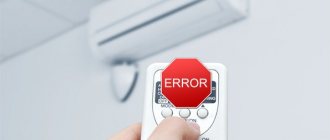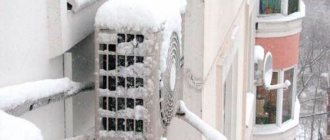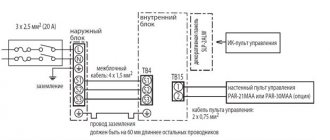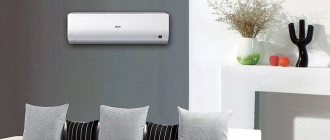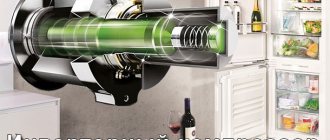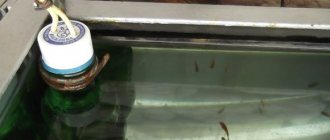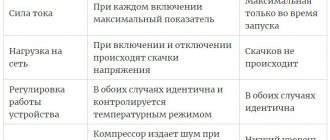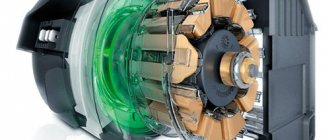Author: Site editors
Publication date: 30.04.2019
Issues discussed in the material:
- What is an inverter air conditioner
- The difference between an inverter air conditioner and a conventional one
- Pros and cons of inverter air conditioner
- Choosing an inverter air conditioner
Inverter air conditioners have appeared in the catalogs of most climate control equipment manufacturers . Experts strongly recommend choosing such equipment. Are inverter devices that good? In order to answer this question, it is necessary to consider the characteristics of inverter equipment and compare them with the parameters of traditional air conditioning systems.
How does a regular air conditioner work?
Conventional air conditioners are called start/stop or on/off systems. In them, the compressor periodically turns on and off. Operating cycle of a non-inverter air conditioner:
- The compressor turns on, freon circulates through the system and cools (heats) the room.
- When the temperature reaches the set temperature, the compressor turns off. The refrigerant stops circulating through the system.
- The indoor fan continues to circulate air to ensure mixing and even temperature distribution.
- When the refrigerant or room air temperature changes by 1-2 degrees, the compressor turns on again.
If the air conditioner is of normal quality, you will not notice that the compressor turns on or off. This can be determined when you are under a stream of air at the moment you turn it on. Depending on the mode (heat or cold), the air from the indoor unit will slightly change the temperature.
In which rooms is it better to install inverter equipment?
Distinctive qualities specific to systems with an inverter:
- low noise level,
- the ability to accurately maintain temperature conditions.
Such devices will be appropriate in the bedroom, children's room, living room, where silence and comfort are important.
Inverters lose to systems with relay technology where the installation operates at extreme conditions, constantly developing maximum power. Their loss under such conditions will render the device ineffective. These rooms include: in an apartment - kitchens and hallways, in a small business - offices, gyms and other places with a strong air flow.
How does an inverter air conditioner work?
In an inverter air conditioner, the compressor does not turn off. It works constantly, but at different speeds. Electricity consumption and performance change accordingly. Inverter air conditioner operating cycle:
- The compressor turns on, the refrigerant circulates through the freon line, and the air in the room is heated or cooled.
- When the temperature reaches the temperature you set, the compressor slows down.
- As soon as the air warms up or cools by 0.5-1 degrees, the compressor picks up speed.
- When the room cools down to the desired level, the speed drops.
When an inverter air conditioner is operating, like a conventional air conditioner, the fan of the indoor unit is constantly running. It is responsible for mixing and distributing air throughout the room. In rooms served by inverter split systems, the temperature difference rarely exceeds 0.5 degrees.
Tips for choosing a model
A split system is an excellent option to get rid of the summer heat and create a comfortable microclimate in your home at any time of the year. In the climate control equipment market, the sale of inverter air conditioners from different manufacturers has been established.
In order not to make a mistake when choosing this expensive air conditioner, you need to know the parameters of these devices. First of all, you need to pay attention, of course, to the power and noiselessness of the unit.
Silence. In the passport for the device, as a rule, this parameter is indicated for the indoor and outdoor modules. Of course, the noise indicator of the first block is more significant, since it is located indoors. In this case, noiselessness is expressed in decibels and should be shown on the air conditioner plate at a level of 22-24 dB.
This noise is almost unnoticeable during the daytime. A split system, by definition, produces less noise than any other system consisting of two blocks. At night, there are fewer extraneous sounds and the noise from the air conditioner is more noticeable.
Therefore, when choosing a model for the bedroom, it is recommended to choose it with a “night mode”. This function makes it possible to reduce noise on some split systems to 18-21 dB.
Power. When choosing performance, these devices have their own peculiarity. Let’s say the device has a power of 2 kW, but you should not accept this figure as valid. The required performance and the power consumed are different characteristics.
Typically, the power to create coolness is about three times greater than consumed. This means that if the calculation results in a power of 2 kW, then the power consumption will be about 700 W. Excessive productivity is also undesirable, as this will lead to unnecessary energy consumption and financial costs.
Location. When choosing which inverter split system or monoblock to choose, the characteristics of the room are of great importance. The outdoor unit can be mounted on a wall, roof or foundation. And the internal module is placed on the floor, wall and even behind suspended ceilings. Where it is impossible to install a wall-mounted unit, you can make your choice on a mobile (floor-standing) inverter air conditioner.
Installation. When installing such expensive inverter air conditioner models, you should pay due attention to the choice of installers. It is recommended to contact the same company (if possible) from which you purchased this unit, since they bear full responsibility for the installation and operation of this air conditioner.
Additional functions.
The efficiency of operation is greatly influenced by many additional modes that are equipped with current inverter devices:
- Heating the apartment during the off-season period.
- Air purification.
- Air ionization.
- Room ventilation.
When choosing a split system based on modes, you need to understand what this or that function gives you. Remember that the more a device has any additional modes, the more expensive it will be.
Why is an inverter more expensive?
No matter how stupid it sounds, an inverter air conditioner has an additional component - a voltage inverter. It is responsible for the speed of the compressor. The more filling there is in a technique, the more expensive it costs.
The operation of a voltage inverter is based on switching a constant voltage source to periodically change the polarity of the voltage at the load terminals. The switching frequency is set by control signals generated by the control circuit (controller).
Article about Voltage Inverters on Wikipedia
The main difference in the structure of conventional non-inverter models from inverter ones is the presence of a voltage inverter. Without it, it is impossible to regulate the operation of the compressor. In simple words, the principle of operation can be explained as follows:
In conventional split systems, the signal from the temperature sensor is processed by the air conditioner control board. It gives a signal when to turn on or turn off the compressor.
In inverter models, the control board responds to the temperature sensor readings. It calculates at what speed the compressor should operate and what voltage is needed for this. The board gives a command to the inverter, which converts standard 220V into the required voltage. The speed of the compressor depends on the voltage applied to it. The smaller it is, the lower the speed.
Inverter operation characteristics
Operating features allow you to understand the difference between a conventional air conditioner and an inverter. The operating characteristics of the latter distinguish the equipment favorably from the classic version.
Inverter technology can operate 24 hours a day. At the same time, energy consumption, according to comments from manufacturers, will be less than that of a conventional air conditioner. The noise level is minimal. There are no drafts. Therefore, this type of device is more comfortable to use. There is also no significant load on the power grid.
But inverter air coolers also have several disadvantages. Their cost is significantly higher than that of conventional air conditioners (30-40%). Also, such a system is more susceptible to the negative influence of voltage surges. Therefore, when purchasing an inverter, you should immediately buy a stabilizer.
A little about efficiency
The second most important characteristic of any air conditioner is the conversion coefficient. It is designated COP (Coefficient Of Performance), sometimes called the efficiency of the air conditioner. The higher it is, the better.
COP is measured not in percentages, but in units. It characterizes the ratio of thermal energy conversion to consumed electricity. For example, if COP = 3, it means that for 1 kW of consumed electricity, 3 kW of heat is supplied (in heating mode) or removed (in cooling mode).
For comparison, the COP of electric heaters is no higher than 0.98. That is, for 1 kW of electricity consumed, it produces 980 W of heat. For fan heaters it is even lower.
The conversion factor depends on:
- Type of refrigerant in the air conditioner (R22, R410a, R32);
- Compressor power;
- Temperature differences between indoors and outdoors.
Air conditioner COP depending on indoor and outdoor temperatures.
Due to the high COP, inverter splits have a larger operating temperature range. Conventional air conditioners can operate for heat when it’s above -5…0 outside, and for cold when it’s +35…+40. With a large temperature difference, their energy consumption increases greatly.
Inverter split systems can work for cooling when the outside air temperature is above +45. The minimum outside temperature for heating is -10...-5 degrees. Some models have a wider range. But they are not classified as air conditioners, but as air-to-air heat pumps.
We are looking for real pros and cons
Let's list the advantages of coolers with inverters, declared by sellers and manufacturers of climate control equipment:
- efficiency 30-60% compared to conventional “splits”;
- reliability, long service life;
- reduced noise level during operation;
- more accurate maintenance of air temperature;
- the ability to heat a house at negative street temperatures of minus 15 °C.
Comment. You need to understand that manufacturers and traders of refrigeration equipment often exaggerate the merits of their products. Example of an advertisement: the lifespan of a conventional cooler is 8-10 years, and that of an inverter cooler is as much as 15 years. The goal is clear: the consumer must believe and buy a more expensive air conditioner for an apartment or private house.
We will analyze the positive aspects separately, and at the end we will lay out the real disadvantages of inverters. First, we suggest you watch the video:
Cost-effectiveness is a relative concept
Air conditioners with variable compressor shaft speed really save energy due to the absence of starting currents and a smooth decrease in performance. It is not for nothing that such a technique was invented in Japan and has found wide application in Europe, where the cost of electricity is quite high.
The operating conditions for climate control household appliances in post-Soviet countries differ from those in Western European countries. Savings from using inverter air conditioners are small for the following reasons:
- The hot season lasts relatively short, and the price of 1 kW of electricity is much lower than European tariffs. If the kilowatts saved during the year are converted into monetary equivalent, the amount will not impress you.
- The inverter also consumes extra energy. Some parts become very hot during operation, converting electricity into heat. Otherwise, why are aluminum heat sinks installed on the board?
- The amount of energy savings depends greatly on the type of space being cooled. The effectiveness of the device is clearly visible in the bedroom, small living room or children's room. Another thing is an office, where employees constantly open windows and entrance doors, work with office equipment, and so on.
Note. Many online resources talk about the efficiency of inverter coolers using the example of a moving car, giving the corresponding picture. Such schemes give a distorted idea of the energy consumption of a frequency converter operating in tandem with a compressor.
Intermediate output. A smooth increase and decrease in power really gives results - less electricity is consumed (the delta compared to a “non-inverter” will be 15-30%). But the effect is offset by low tariffs, a short hot season and the consumption of the inverter unit itself. Against the backdrop of the price of equipment and spare parts, energy saving becomes illusory.
Scheme of operation algorithms for various air conditioners
Reliability and service life of units
In order not to take up the reader’s precious time, we will present the analysis of these advantages in the form of brief theses:
- The most vulnerable unit of a refrigeration machine is the compressor. In second place is electronics.
- On the one hand, the lack of starts/stops increases the life of the inverter supercharger. On the other hand, the service life is reduced due to continuous operation.
- Practice shows: new branded inverters (not cheap Chinese ones) really last a long time. Only the reason is different - the introduction of modern technologies, for example, scroll and two-rotor compressors with DC electric motors.
- Voltage surges in our network can cause damage to any electronics, regardless of the type of air conditioner. Repairing the inverter will cost much more.
- If the cooler has not been serviced for years, is operated with a lack of freon or clogged heat exchangers, the result will be the same - a breakdown of the supercharger. The presence of a frequency converter does not matter.
Diagram of the operation of a rotary compressor installed in various types of split systems
Hence the conclusion: a standard “split” is not inferior to an inverter in terms of reliability and durability, and if the electronics are replaced, it will win in terms of the price of parts. We are talking about high-quality equipment from proven brands - Daikin, Mitsubishi, York and the like. There is no point in comparing Chinese products.
Are inverters noisy?
In any air conditioner there are three units that make noise:
- compressor;
- axial fan of the external module;
- turbine fan of the indoor unit.
The first two elements are placed outside the home (excluding window and mobile versions of air conditioners). In addition, modern inverter split systems are equipped with low-noise blowers; they are practically inaudible behind the wall. The axial impeller starts periodically and does not bother residents with extraneous sounds.
The turbine of the internal split module is clearly noisy. The sound level depends only on its design, the inverter does not play a role. But the latest generation machines still have an advantage - they get advanced developments, for example, an impeller with a special blade profile. This is how the myth about the noiselessness of inverter models arises.
Accurate temperature control
A cooler equipped with a frequency converter more accurately maintains the set temperature, this is an indisputable fact. The problem is different: sellers associate this feature with preserving the health of residents, although in reality we are talking about a comfortable stay inside the room. Precisely maintaining the air temperature eliminates the feeling of stuffiness and cold when the standard split model is turned off.
Reference. In the vast majority of cases, people catch colds from sudden climate change. Example: while actively moving along the street in the middle of summer, you enter a room with a temperature of +21 °C. A hot body cools down sharply, which often causes a cold.
We will again describe heating using an inverter briefly:
- In the previous generation of installations, street blocks froze and oil froze in the compressor crankcase.
- Inverters do not have this problem - the units continue to operate down to minus 15 degrees.
- With a reverse cycle, the efficiency of heat transfer decreases sharply along with the outside air temperature. Inverter devices are capable of working, but in severe frost they heat the room rather weakly.
- How it looks in practice: the internal turbine turns on much less frequently, and the breaks between starts increase. The air stream is barely warm.
Conclusion: during the cold period, all air conditioners are able to effectively heat the air as long as it is 0...+5 °C outside. In cold weather, the heating intensity decreases noticeably, although the inverter can physically function. The device simply does not have enough heat exchange surface area due to the small size of the condenser.
The photo shows external modules of a Mitsubishi Zubadan inverter heat pump. The dimensions are very different from the blocks of a household split system
Reference. In air-to-air or air-to-water heat pumps, which are descendants of split systems, the issue of efficiency is resolved by increasing the size of external heat exchangers.
Briefly about the disadvantages
Having analyzed the real advantages of inverter air conditioning units, we can talk about the following disadvantages:
- high initial price of equipment, on average 30% more than “non-inverter” devices;
- expensive repair of electronic components;
- questionable reliability of frequency converters - boards often become unusable due to power surges.
The advantages of inverters over classical models in our conditions are minimal. A noticeable reduction in electricity consumption is observed with year-round use (heating + cooling) in living rooms.
Differences between an inverter air conditioner and a conventional one
Longer service life . The compressor does not experience stress when turned on constantly. It wears out more slowly, and this is the heart of any air conditioner.
Costs more . An inverter split has an additional unit - an inverter. Accordingly, it cannot cost the same as a regular, non-inverter model. But the price gap is narrowing every year.
Less electricity consumption . An inverter air conditioner does not have the starting currents required to start the compressor. They can significantly affect energy consumption. The COP of inverter air conditioners is higher due to the size and volume of the evaporator and condenser.
Precise temperature maintenance . Indoor temperature will fluctuate between 0.5-1 degrees. For start-stop systems, this range is within 2-4 degrees.
Few people will tell you about this
Small temperature changes are not noticeable. But your body reacts to them. If it gets a little cooler, your metabolism speeds up and your body begins to produce more heat. If it gets warmer, the processes slow down, but not immediately.
It's a little stressful, but still stressful. It is generally harmless, but in some people it can cause fatigue, malaise, and decreased vitality. If you are weather dependent, or have small children in the family, start-stop air conditioning is a bad option.
Fast heating and cooling . When turned on for the first time, it warms or cools the room faster than a regular on/off air conditioner.
There are no power surges in the network . To turn on the compressor of a non-inverter air conditioner, a high starting current is required. Because of this, there may be voltage drops; it can drop to 170V. The inverter system starts the compressor only once when turned on.
Expensive repairs . It takes more time to determine the breakdown. Some spare parts are difficult to obtain and are expensive. Repairs should be performed by a professional who is familiar with electronics.
Wide operating temperature range . When a conventional air conditioner cannot cope, an inverter air conditioner can work. At the same time, its COP will always be greater than 1. It will produce more heat or cold than it will consume electricity.
Preventative work
If you use the air conditioner for a long time, dust and grease accumulate on its elements. This applies to the heatsink, filters, fans and other parts inside the case. As a result, microorganisms harmful to human health are formed in these places and are carried along with the air.
Dirt deposits negatively affect the operation of all equipment, which requires cleaning the components and performing basic preventative repairs of the device. If you do not do this, then after some time the air exchange will noticeably deteriorate and the load on the device and the electrical network will increase.
In addition, fluff and leaves collect on the body of the outdoor unit, which changes the operation of the heat exchanger and worsens the refrigerant conversion procedure. Thus, when servicing such climate control equipment, you can clean or change dirty filters, a condenser (heat exchanger) from dust and fluff, and a fan from fat deposits.
All these works are specified in the instructions for this device. The rest of the preventive maintenance should be left to the specialists from the service center. In order to fully complete the scope of work, you must have experience in maintenance, as well as special tools and equipment.
To avoid incorrect maintenance and possible health risks, the best option is to entrust this process to professionals. This will save you energy, time and protect you from danger.
Myths and fairy tales about inverter air conditioners
The inverter air conditioner does not make noise . Yes it is. But is a regular, non-inverter one noisy? Modern start-stop split systems operate quietly, almost silently. If the air conditioner starts to rustle, click, or just work loudly, call a professional.
With an inverter air conditioner, 30-40% of electricity is saved . The entire Internet is full of such statements. One of the cunning sellers started this canard and it is reprinted in 90% of articles about air conditioners. Such savings can be achieved if you replace a twenty-year-old unit with a modern one.
Inverter split systems are more environmentally friendly . This expression is simply a PR move by sellers and manufacturers of air conditioners. Freon has an impact on the environment when it leaks. It all depends on its type. Different types of refrigerants have different effects on global warming and the Earth's ozone layer.
Which cooler is better to choose?
Regarding the choice of a split system, we will give several recommendations:
- The inverter is appropriate in living rooms where no more than three people stay at the same time - children's room, bedroom, living room.
- For a kitchen, large hall or office, it is better to take a traditional air conditioner.
- If your budget is limited, you should buy a classic model from a reliable manufacturer. A cheap inverter from the Middle Kingdom will cause a lot of problems, ranging from noise to repairs.
- Do not expect that the inverter version of the “split” will replace full heating of the room in winter.
When choosing an air conditioner, remember a simple rule: the higher the cost of the product, the more expensive its repairs and spare parts. Instead of a conclusion, we suggest watching a thematic video:
How much can you save?
This is perhaps the most important question when choosing the type of air conditioner. There is no clear answer to this. Savings depend on many factors, such as:
- Cost per kilowatt of electricity;
- air conditioner COP;
- Temperatures inside and outside the room.
Inverter air conditioners using R410a or R22 freon will help save 5-15% of electricity. If the split system runs on R32 refrigerant, the savings will be 10-25%. You can see the average consumption of air conditioners depending on power in this table:
| BTU | Power | Consumption |
| 5000 | 1.5 kW | 0.55 kW |
| 7000 | 2.1 kW | 0.75 kW |
| 8000 | 2.3 kW | 0.8 kW |
| 9000 | 2.6 kW | 0.9 kW |
| 10000 | 2.9 kW | 1 kW |
| 12000 | 3.5 kW | 1.25 kW |
| 15000 | 4.4 kW | 1.55 kW |
The label shows the heating output of air conditioners in BTU (British Thermal Units) and kW. The average values of electricity consumption when operating at rated power are given. Some models may have higher or lower consumption.
In common parlance, air conditioners are called by their thermal power:
- Seven – 7000 BTU;
- Nine – 9000 BTU;
- Twelve - 12000 BTU.
You also need to take into account that the price of electricity may depend on the time of day. It is different in houses with gas and electric stoves. Tariffs in different cities may differ by 3-4 times. At the time of writing, one kW in Irkutsk cost 5 times less than in Moscow. Therefore, it is better to calculate savings in kilowatts.
Important
All calculations below are based on average statistical data. Actual energy consumption varies depending on the climate in your area, frequency and time of use of the air conditioner, its characteristics, etc.
Cooling savings
On average, air conditioning is used for cooling 450 hours per year. In mid-latitudes, it spends the same amount of time heating. Of course, in the south there is no point in heating a house or apartment with air conditioning. Just like cooling your home in the north of the country. Therefore, let's calculate how much an inverter air conditioner can save in kilowatts.
On average, an office air conditioner works 700 hours a year for cooling. 'This is based on an 8-hour working day and a 5-day working week.
A home air conditioner operates in cooling mode for about 450 hours a year. This is the case if you don’t use it at night, but turn it on after hours, when it’s really hot outside.
By simple calculations you can calculate how much an inverter air conditioner can save depending on the type and freon used:
Savings when heating with an inverter air conditioner
When it comes to heating, the numbers are completely different. In summer, you can turn off the air conditioning when you are at work; Do not use it in the morning until the air has warmed up. During the cold season, it is necessary to maintain a constant temperature.
On average, the air conditioner will work for heat for 120 days or 2880 hours. Based on this, let’s calculate how much an inverter air conditioner can save:
As can be seen from the last two tables, heating costs are much higher than cooling costs. Is it worth overpaying for an inverter air conditioner if you are only going to use it in the summer? Hardly. But if you have a private house, then this is a good alternative to heating with electricity, gas, wood or coal.
Let us remind you once again that all values are averaged. Each air conditioner has its own heating and cooling capacity, COP. If you replace an expensive start-stop system with a cheap inverter air conditioner, your energy costs may even increase.
Split system device
Externally, air conditioners of both types of action do not differ from each other. The technical difference is that the switching relay in the inverter version is replaced by a frequency converter, which is a power electronics unit.
It includes:
- rectifier , which converts standard alternating current into direct current;
- inverter , which converts direct current into alternating current of the required frequency.
The operation of the inverter is regulated by a special controller integrated into the electronic system control unit. It determines the frequency of the current supplied to the generator, thus controlling the rotation speed of the compressor motor.
A split cooling system consists of two blocks, one of which is located indoors and the other outdoors.
The outdoor unit of inverter-type devices includes the following main elements:
- a condenser (usually in the form of a radiator with a fan), in which cooling and phase transition of freon occurs;
- compressor , which compresses freon or other refrigerant and ensures movement along the circuit;
- freon system filter , protecting the compressor from dirt;
- four-way valve that reverses the freon flow when changing the cooling mode to heating and back;
- a frequency converter;
- external unit control board
For conventional air conditioners, all electronics are usually located in the indoor unit and are less susceptible to dust and temperature changes. The reason for moving the power electronics board outside is heat generation from the inverter.
Since the external block of the inverter system contains an expensive frequency converter board, it is necessary to provide additional protection from the effects of precipitation
The indoor unit includes the following devices:
- evaporator (radiator with fan), in which the refrigerant is heated by cooling the incoming air;
- coarse filter , designed to capture large suspended matter, such as dust, animal hair or fluff;
- fine filter system (carbon, antibacterial, electrostatic, etc.);
- indoor unit control board
- front panel through which air enters the unit;
- horizontal and vertical blinds designed to adjust the direction of the outgoing flow;
- indicator panel.
Copper tubes connecting the indoor and outdoor units are connected using a special fitting connection.
So is it worth paying extra for an inverter air conditioner?
It's time to take stock. In short, an inverter air conditioner is worth buying if:
- The family has small children;
- You are going to use the air conditioner for heating;
- Your region experiences severe frosts in winter or heat in summer;
- The air conditioner will operate for more than 6 months per year.
In the article we talked about the differences between conventional split systems and inverter ones. They provided an approximate calculation of electricity consumption and potential savings. Whether it’s worth overpaying for an inverter air conditioner is up to you to decide. This largely depends on your specific situation and your budget.
Do you want to get help from a master, a specialist in this field? Go to the professional search portal. This is a completely free service where you will find a professional who will solve your problem. You do not pay for posting an ad, views, or choosing a contractor. If you are a master of your craft, then register on Pro and receive a flow of clients. Your profit is just one click away!
Latest publications
- Which freezer is better, No Frost or regular?
- Top 10 air conditioners for apartments 2020-2021
- 30+ reasons: Why the refrigerator makes strange sounds, how to fix the problem
- 6 brands and 6 models: Which refrigerator to buy, inexpensive but good, with No Frost
- 20+ reasons: Why the refrigerator works but does not freeze, what is the problem, how to fix it
- Atlant, Biryusa, Indesit - which refrigerator is better and why
- Is it possible to place a refrigerator next to the stove? How to protect your refrigerator?
- TOP 10 best manufacturers and brands of refrigerators today
- Freon R407c - characteristics, features of use and replacement
- 13 reasons why the refrigerator constantly works and does not turn off
Main differences between the systems
Despite a large number of similar characteristics and the same appearance, the presented subtypes of climate control equipment have quite a lot of differences, some of them cardinal.
This makes inverter and conventional systems different types of climate control equipment.
The main difference between these climate systems is the operating principle. As a result, inverter air conditioners are more stable in maintaining the set temperature, and are also more economical
The differences include: operating principle, functionality, stability, durability, energy consumption, noise, cost.
A large number of differences indicate that before purchasing an inverter or conventional climate system, you should get to know them better. Find out more specifically about the features of their work, because the correct choice depends on this.
#1 – operating principle
Conventional systems operate cyclically, that is, the user sets the temperature he needs, which is controlled by a temperature sensor.
When the desired value is reached, the compressor automatically turns off. And it turns on when you deviate from the set parameter by a few degrees.
Buyers will always be told that inverter systems are more economical in terms of energy consumption, and this is true. But the high cost of products belonging to this category stops many potential buyers.
Unlike their conventional counterparts, inverter systems operate continuously. So, when the desired temperature is reached, their compressors do not turn off, but reduce productivity.
For example, they are able to effectively maintain a comfortable temperature by operating at 5-10% of their power.
#2 – device functionality
Both subtypes of climate control equipment cope equally well with air cooling. However, inverter split systems are more functional.
The reason is that they are suitable for use even in winter, because such equipment can effectively heat the room. Moreover, even at temperatures reaching low -25°C.
When choosing the optimal option for split systems, you should take into account their advantages and disadvantages. Therefore, it is better to use inverter equipment for cooling air in apartments and houses, where it will be most efficient
Traditional air conditioners are also equipped with a heating function, but you should know that it can only be used if the temperature has not dropped below -5°C. The reason for this feature is the described cyclical operation, which leads to the fact that conventional air conditioners do not work much of the time.
At this time, the lubricant of their moving parts flows down and thickens. Subsequent activation results in at least significant wear.
As a result, a traditional air conditioner that is regularly used at a specified temperature usually does not survive until the coming spring. And in some cases, the first launch leads to jamming, with sad consequences in the form of expensive repairs.
Inverter equipment does not have this drawback due to the fact that it is always in operation, which prevents the lubricant from thickening.
For walk-through areas such as offices and shops, the optimal choice would be a conventional system that can quickly respond to temperature changes
An important point is the cooling rate of the desired room. And in this matter, traditional systems are somewhat inferior to their analogues. To be precise, under equal conditions they will cope with the task, spending, on average, 2 times more time.
But this is not critical, because in most situations, users do not care how long air conditioners spend cooling the air - 5 or 10 minutes.
#3 – stability
The differences in operating principle described above lead to the fact that inverter air conditioners support user-specified parameters more accurately. For example, their deviation does not exceed 1-1.5°C, and often it does not go beyond half a degree.
Similar values for traditional systems can reach from 1 to 5 °C. Moreover, in most cases the deviation delta is within 3 °C
#4 – equipment durability
As a result of cyclic inclusions, the load on the structural elements of conventional systems is higher, which leads to faster wear of a number of mechanical components. Inverter air conditioners do not have this drawback.
Since they operate continuously and allow less significant deviations from the specified temperature conditions, their parts are subject to less stress, which extends their service life.
There are a large number of units of these types available on the market, so you can make the best choice for any room. And their aesthetic qualities can satisfy the wishes of all customers.
Thus, inverter models, on average, are able to provide indoor comfort for an impressive 8-16 years. Then, like their conventional counterparts, in many cases they will not be able to please owners for more than 5-10 years.
#5 – energy consumption level
The operating principle of both subtypes significantly affects electricity consumption. The cyclical nature of traditional equipment leads to the fact that during peak loads, significant energy consumption always occurs. Inverter products, which operate at maximum power extremely rarely, do not have this feature.
This indicates that in a number of modes they will be 30-50% more economical. At the same time, inverter products work constantly, which also should not be overlooked.
In most cases, inverter models are more economical, but the result can only be obtained after a long 7-8 years
#6 – noise level
The noisiest structural elements of both types of equipment are located in external units located on the street. However, the internal parts of the structure also produce hum and are louder in operation than conventional systems.
For example, the average noise level of inverter equipment lies in the range of 19-23 dB, and the same indicator for the usual subtype reaches 30-32 dB. But it should be understood that the sounds produced will not irritate most users in both cases.
In terms of maintenance, both types of systems are similar. That is, they will have to be regularly cleaned and refilled with freon. If the above rules are ignored, the service life is significantly reduced and it will not be possible to achieve the maximum effect when cooling the air.
#7 – price category
Even a person far from technology, after reading the information presented above, will be able to conclude that inverter climate control equipment is more high-tech and modern.
However, you will have to pay for this, and quite a lot. For example, ordinary products cost 30-40% less, and in many cases the difference reaches more impressive values.
The best models of conventional air conditioners
A large number of new models of inverter equipment did not affect the range represented by simple devices. Among the presented line of models, there are several that are loved and have proven themselves well. Among them, 3 models stand out.
ELECTROLUX EACS-07HG/N3
The best choice of buyers is considered to be a device that stands out in design and cost. Beautiful external design did not affect the cost of the equipment and its characteristics. For many users, the design of the model plays a decisive role. In addition, it has low power consumption and a modern, efficient filter with plasma elements to combat dust and odors. The equipment serves 20 sq. m of premises. The external unit is protected by a function that prevents icing, and the unit inside the house has very modest dimensions.
Indicators:
- production – China;
- cooling efficiency 2100W/heat generation 2200W;
- electricity consumption A;
- noise level 32-37 dB.
The average price is 23,000 rubles.
ELECTROLUX EACS-07HG/N3
BALLU BSE-09HN1
A classic example of a simple air conditioner that has the lowest cost among its competitors. Can effectively maintain the desired regime in an area of up to 29 square meters. m. The equipment is equipped with a good system for cleaning the space from germs and unpleasant odors. The airflow can be controlled by remote control, and the internal filter contains vitamin C additives.
Basic properties:
- production – China;
- energy consumption category A;
- The power of the air conditioning system is 2600 W / heating 2700 W.
The price on the market is 14,000 rubles.
BALLU BSE-09HN1
HISENSE AS-10HR4SYDTG
The system is wall-mounted and has the highest air purification efficiency in its category. The air conditioner is equipped with a photocatalytic function and a unique silver ion filter. With the help of these features, the manufacturer achieves a high level of purification from harmful bacteria and viruses, and gets rid of the smallest particles of dust and unpleasant odors.
The system provides efficient servicing of a room up to 30 square meters. m. The air conditioner has established itself as a stylish and reliable device with a fairly low noise level and high efficiency.
Characteristics:
- country of origin – China;
- energy class A;
- self-cleaning function;
- cold generation capacity 2700W/heat 2750W;
- external noise level 29-40 dB.
The average cost is 18,500 rubles.
HISENSE AS-10HR4SYDTG
The working process of a conventional air conditioning system
A simple air conditioner is available in a wide range of affordable models. Its internal processes include the ability to circulate heat, through its absorption in the form of steam and release through condensation. Conventional air conditioners deal exclusively with circulating air from the outdoor space to the indoor space and back. This type of system cannot independently create a decrease or increase in temperature.
A regular air conditioner is divided into 2 blocks:
- Inner part. Functions as an evaporator.
- Outer box Performs the functions of a capacitor.
The principle of operation is to cool the air to the temperature set by the user. After heating, the compressor stops and goes into sleep mode, at which time the fan continues to function, monitoring the temperature in the room using a sensor. If the space is heated by a certain number of degrees provided by the system, the compressor is activated again.
Internal structure and operation of a conventional air conditioner
